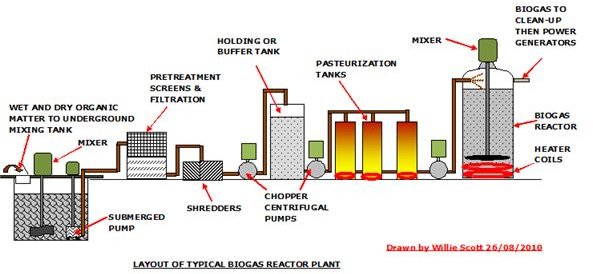What is a Biogas Reactor?
Introduction to Biogas Reactors
Biogas reactors are used to convert liquid manure, sewage sludge, and vegetable matter into methane, a renewable energy biogas.
The sludge remaining after processing the organic matter is used as a fertilizer.
This is an article on energy/power plants, where we examine the processes involved in producing biogas for use in a power plant. We begin then with a look at the types of organic matter used in the biogas reactors.
Types of Organic Matter Used by a Biogas Reactor
Agriculture Matter
- Liquid manure.
- Residues such a straw used in barns for bedding cows.
Abattoir Waste
- Blood, inedible offal, and liquid manure.
Supermarkets
- Food, fruit, and vegetables past their sell-by dates.
Local Community
- Grass cuttings.
- Household organic-waste.
- Sewage plants sludge.
Restaurants
- Leftover food, fruit, and vegetables.
- Cooking fat and grease.
Reference Webs: ruralenergy - organic matter
Biogas Reactor Categories by Operating Temperature and Bacteria
There are three categories of biogas reactors, distinguishable by their operating temperatures and the type of active bacteria:
1. Phychrophilic.
Here this bacteria produce methane at low temperature; 45 to 50°F usually naturally as in marshes as marsh gas.
2. Mesophilic.
This bacteria function at medium temperatures; 68 to 105°F, but they are most efficient at 95-98°F and this is the normal temperatures used in anaerobic digesters today.
3. Thermophilic
This is a high temperature operating bacteria; 140 to 145°F, which will give the highest gas yield. However, the bacteria are not very stable at these elevated temperatures, which are also costly to maintain.
Reference Web: wisedu- active bacteria temperatures
Biogas Reactors – Pre Treatment of Organic Matter
When the feedstock arrives at the biogas plant, it is segregated, the dryer organic matter such as food, grass and animal bedding being dumped into underground concrete chambers and subjected to mechanical mixing. Liquid matter can then be added and the resultant slurry is then pumped to a mechanical filtration/pretreatment plant which removes glass, plastic, and metals.
From here it is subjected to maceration by shredding, with the resultant slurry being reduced to 12mm pieces as per EU Regulations, but also to aid degradation.
This is pumped to a holding or buffer tank, normally by a chopper pump, then fed through the pasteurizing tanks, after which it is pumped into the bio reactor.
Reference Webs:
- methanetomarket - pretreatment of organic matter
- esrustrath - pasteurizing to eradicate pathogens
- weirpower - chopper pumps
- biogasrenewable - volumes of biogas produced from various feed stocks
Biogas Reactors - Operation
The biogas reactor is a fabricated vertical steel tank being insulated on the outside. It has heating coils and a stirring mechanism usually of a paddle design built into the tank.
The pretreated slurry is pumped into the top of the tank, spraying downwards to build up at the bottom of the tank.
Here it is stirred continuously whilst being heated to the temperature required by the particular process.
As we have seen earlier, the most common process is Mesophilic, the optimum temperature to suit the micro-organisms being 95-98°F, so we will examine this process.
The process begins with the circulation of the organic slurry from the holding tank through the pasteurization tanks, of which there are three. These heat the slurry to 160°F; holding the temperature for at least one hour, ensuring that any pathogens are eradicated.
It is then pumped into the biogas reactor where the organic slurry is degraded by the inherent micro-organisms. Using a combination of the application of the right degree of heat in the absence of oxygen, these micro-organisms multiply as the anaerobic process advances, which can be continuous or batch. We shall examine a batch process, where from entering the biogas reactor as slurry and exiting as biogas, takes an average of 28 days of processing.
In the anaerobic conditions and the temperature of the reactor, the micro-organisms degrade the components of the slurry, processing them in the manner shown in the following flow diagram:

As shown in the flow diagram, there are four definitive stages for the organic slurry to undergo inside the anaerobic reactor before the biogas is finally produced, taking almost a month per batch.
Once the process is complete (through practice the operators of the plant will know when this stage is reached) the reactor is opened and the residual sludge removed for further processing to dry or wet agricultural fertilizer. This is a great saving in energy and CO2 emissions, as synthetic fertilizers are a large source of this major component of greenhouse gases.
Reference Webs:
- biogas - production of biogas.
- esrustrath - processing biogas
- proactivenergy - latest technology.
- energyfromwaste - A Bright Hub article on energy from waste.
Images Section - A Process Flow Diagram for a Typical Biogas Reactor System
